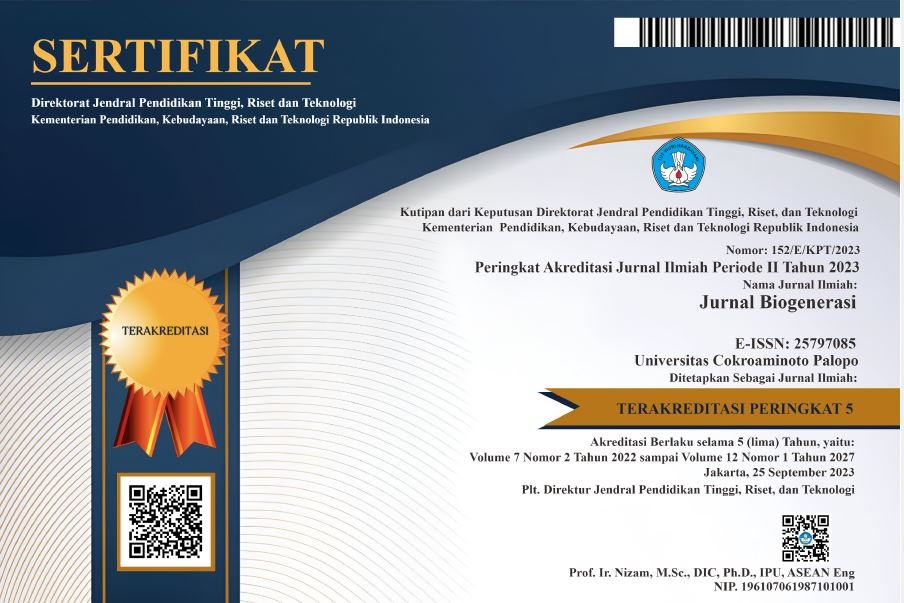KEANEKARAGAMAN JENIS KUPU-KUPU LEPIDOPTERA DISEKITAR KAMPUS UNIVERSITAS SAN PEDRO, KOTA KUPANG NUSA TENGGARA TIMUR
DOI:
https://doi.org/10.30605/biogenerasi.v10i3.6784Keywords:
Butterflies, Lepidoptera,, University, Nymphalidae, DiversitasAbstract
The objective of this study is to identify butterfly species within the vicinity of Universitas San Pedro. The research was conducted across the university campus, utilizing roaming and point count methods at four designated stations. The Lepidoptera butterfly species diversity at Universitas San Pedro encompasses Nymphalidae, comprising 11 species totaling 111 individuals, along with Pieridae with 6 species and 54 individuals, Papilionidae with 5 species and 40 individuals, Lycaenidae with 3 species and 20 individuals, and Hesperidae with 2 species and 16 individuals. The average Lepidoptera butterfly diversity index is 3.202, indicating a high level of diversity, along with an evenness index of 0.972, signifying uniformity and stability within the Lepidoptera butterfly community surrounding Universitas San Pedro. Conversely, the average dominance index of 0.044 denotes a low dominance of Lepidoptera butterfly species within the area
Downloads
References
Fahik, M,. (2023). Identifikasi Jenis Serangga Di Sekitar Tanaman Padi Areal Persawahan Motaulun Malaka Barat. Jurnal Biogenerasi, 8(2), 623–627. https://doi.org/10.30605/biogenerasi.v8i2.3982
Fahik, M,. (2024). Keanekaragaman Jenis Pohon Disekitar Universitas San Pedro, Kota Kupang Nusa Tenggara Timur. Jurnal Biogenerasi, 10(1),169–174. https://doi.org/10.30605/biogenerasi.v10i1.4486
Henry, E. H., Haddad, N. M., Wilson, J., Hughes, P., & Gardner, B. (2015). Point-Count Methods to Monitor Butterfly Populations when Traditional Methods Fail: A Case Study with Miami Blue Butterfly. Journal of Insect Conservation, 19:519-529. http://dx.doi.org/10.1007/s10841-015-9773-6.
Ismail, N., Rahman, A. A. A., Mohamed, M., Abu Bakar, M. F., & Tokiman, L. (2020). Butterfly as bioindicator for development of conservation areas in Bukit Reban Kambing, Bukit Belading and Bukit Tukau, Johor, Malaysia. Biodiversitas Journal of Biological Diversity, 21(1), 334–344. https://doi.org/10.13057/biodiv/d210142
Jumar. (2000). Entomologi pertanian (Cet. 1). Jakarta: Rineka Cipta
Lestari, V., Erawan, T., Melanie, Kasmara, H., & Hermawan, W. (2018). Keanekaragaman Jenis Kupu kupu Familia Nymphalidae dan Pieridae di Kawasan Cirengganis dan Padang Rumput Cikamal Cagar Alam Pananjung Pangandaran. Jurnal Agrikultura ,9(1), 1-8. https://doi.org/10.24198/agrikultura.v29i1.16920.
Magurran, A,. (1988). Ecological Diversity and Its Measurement. Princeton University Press, New Jersey. ISBN 978-94-015-7360-3, pp: 179.
Nurhadi, A., & Setiawan, R. (2024). Keragaman kupu-kupu sebagai indikator kesehatan ekosistem di Hutan Tampusu dan sekitarnya. Silvarum: Jurnal Penelitian Kehutanan, 15(1), 45–58. https://ejournal.unsrat.ac.id/index.php/silvarum/article/view/53946
Pendl, M., Hussain, R. I., Moser, D., Frank, T., & Drapela, T. (2022). Influences of landscape structure on butterfly diversity in urban private gardens using a citizen science approach. Urban Ecosystems, 25, 477–486. https://doi.org/10.1007/s11252-021-01168-6
Peggie, D., & Amir, M. (2006). Practical Guide to the Butterflies of Bogor Botanic Garden = Panduan Praktis Kupu Kupu di Kebun Raya Bogor. Pusat Penelitian dan Pengembangan Biologi, Lembaga Ilmu Pengetahuan Indonesia.
Priyono, A., Suwignyo, R. A., & Marlina, D. (2012). Teknik penangkapan dan pengawetan serangga untuk kegiatan praktikum entomologi. Jakarta: Direktorat Jenderal Pendidikan Tinggi.
Priyono, B., & Abdullah, M. (2013). Keanekaragaman jenis kupu-kupu di Taman Kehati Unnes. Biosaintifika: Journal of Biology & Biology Education, 5(2), 165–170. https://doi.org/10.15294/biosaintifika.v5i2.2749
Ruslan, H., Satiyo, A., & Yenisbar, Y. (2023). Diversity of butterflies (Lepidoptera: Papilionoidae) in the Bodogol Nature Conservation Education Center Area, Gunung Gede Pangrango National Park, West Java. Jurnal Entomologi Indonesia,20(1),10–21. https://doi.org/10.5994/jei.20.1.10
Tsukada, E., & Nishiyama, Y. (1982). Butterflies of the South East Asian Islands (Vol. I: Papilionidae). Tokyo: Plapac Co., Ltd.
Tsukada, E., Nishiyama, Y., & Kaneko, M. (1985). Butterflies of the South East Asian Islands (Vol. IV: Nymphalidae, Part 1; Tsukada, Ed.). Tokyo: Plapac Co., Ltd.
Tsukada, E. (1991). Butterflies of the South East Asian Islands (Vol. V: Nymphalidae, Part 2; Tsukada, Ed.). Tokyo: Azumino Butterflies Research Institute
Downloads
Published
How to Cite
Issue
Section
License
Copyright (c) 2025 Mery Fahik, Agustina Lodo Rame

This work is licensed under a Creative Commons Attribution 4.0 International License.
In submitting the manuscript to the journal, the authors certify that:
- They are authorized by their co-authors to enter into these arrangements.
- The work described has not been formally published before, except in the form of an abstract or as part of a published lecture, review, thesis, or overlay journal.
- That it is not under consideration for publication elsewhere,
- That its publication has been approved by all the author(s) and by the responsible authorities – tacitly or explicitly – of the institutes where the work has been carried out.
- They secure the right to reproduce any material that has already been published or copyrighted elsewhere.
- They agree to the following license and copyright agreement.
License and Copyright Agreement
Authors who publish with this journal agree to the following terms:
- Authors retain copyright and grant the journal right of first publication with the work simultaneously licensed under Creative Commons Attribution License (CC BY 4.0) that allows others to share the work with an acknowledgment of the work's authorship and initial publication in this journal.
- Authors are able to enter into separate, additional contractual arrangements for the non-exclusive distribution of the journal's published version of the work (e.g., post it to an institutional repository or publish it in a book), with an acknowledgment of its initial publication in this journal.
- Authors are permitted and encouraged to post their work online (e.g., in institutional repositories or on their website) prior to and during the submission process, as it can lead to productive exchanges, as well as earlier and greater citation of published work.


.png)

